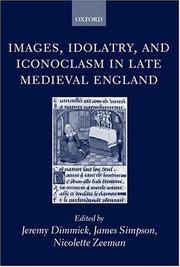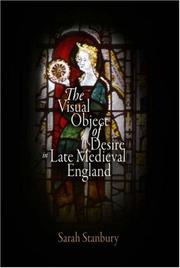| Listing 1 - 3 of 3 |
Sort by
|
Book
Year: 1919 Publisher: London : T. Werner Laurie,
Abstract | Keywords | Export | Availability | Bookmark
 Loading...
Loading...Choose an application
- Reference Manager
- EndNote
- RefWorks (Direct export to RefWorks)
THEATRE (GENRE LITTERAIRE) --- ICONOCLASME DANS LA LITTERATURE --- 20E SIECLE

ISBN: 0198187599 9780198187592 Year: 2002 Publisher: Oxford [etc.] : Oxford University Press,
Abstract | Keywords | Export | Availability | Bookmark
 Loading...
Loading...Choose an application
- Reference Manager
- EndNote
- RefWorks (Direct export to RefWorks)
History of civilization --- History of the United Kingdom and Ireland --- Iconography --- anno 1500-1599 --- English literature --- Iconoclasm --- Christianity and literature --- Idols and images --- Littérature anglaise --- Iconoclasme --- Christianisme et littérature --- Idoles et images --- History and criticism --- History --- Histoire et critique --- Histoire --- England --- Angleterre --- Church history --- Histoire religieuse --- Art and literature --- Idols and images in literature. --- Iconoclasm in literature. --- Idols and images in art. --- Idolatry in literature. --- Idolatry in art. --- History and criticism. --- Civilization --- Littérature anglaise --- Christianisme et littérature --- History. --- English literature - Middle English, 1100-1500 - History and criticism. --- Iconoclasm - England - History - To 1500. --- Christianity and literature - England - History - To 1500. --- Art and literature - England - History - To 1500. --- LITTERATURE ANGLAISE --- ICONOCLASME --- CHRISTIANISME ET LITTERATURE --- ART ET LITTERATURE --- IDOLES ET IMAGES DANS LA LITTERATURE --- ICONOCLASME DANS LA LITTERATURE --- IDOLES ET IMAGES DANS L'ART --- IDOLATRIE DANS LA LITTERATURE --- IDOLATRIE DANS L'ART --- ANGLETERRE --- 1100-1500 (MOYEN-ANGLAIS) --- HISTOIRE ET CRITIQUE --- JUSQUE 1500 --- GRANDE-BRETAGNE --- HISTOIRE --- AVANT 1500 --- CIVILISATION --- 1066-1485

ISBN: 0812240383 1512808296 9780812240382 Year: 2015 Publisher: Philadelphia : University of Pennsylvania Press,
Abstract | Keywords | Export | Availability | Bookmark
 Loading...
Loading...Choose an application
- Reference Manager
- EndNote
- RefWorks (Direct export to RefWorks)
Little remains of the rich visual culture of late medieval English piety. The century and a half leading up to the Reformation had seen an unparalleled growth of devotional arts, as chapels, parish churches, and cathedrals came to be filled with images in stone, wood, alabaster, glass, embroidery, and paint of newly personalized saints, angels, and the Holy Family. But much of this fell victim to the Royal Injunctions of September 1538, when parish officials were ordered to remove images from their churches.In this highly insightful book Sarah Stanbury explores the lost traffic in images in late medieval England and its impact on contemporary authors and artists. For Chaucer, Nicholas Love, and Margery Kempe, the image debate provides an urgent language for exploring the demands of a material devotional culture-though these writers by no means agree on the ethics of those demands. The chronicler Henry Knighton invoked a statue of St. Katherine to illustrate a lurid story about image-breaking Lollards. Later John Capgrave wrote a long Katherine legend that comments, through the drama of a saint in action, on the powers and uses of religious images. As Stanbury contends, England in the late Middle Ages was keenly attuned to and troubled by its "culture of the spectacle," whether this spectacle took the form of a newly made queen in Chaucer's Clerk's Tale or of the animate Christ in Norwich Cathedral's Despenser Retable. In picturing images and icons, these texts were responding to reformist controversies as well as to the social and economic demands of things themselves, the provocative objects that made up the fabric of ritual life.
Iconoclasm in literature. --- Idols and images in literature. --- Christian art and symbolism in literature. --- Art and literature --- Civilization, Medieval, in literature --- Iconoclasme dans la littérature --- Idoles et images dans la littérature --- Art et symbolisme chrétiens dans la littérature --- Art et littérature --- Civilisation médiévale dans la littérature --- Iconoclasme dans la littérature --- Idoles et images dans la littérature --- Art et symbolisme chrétiens dans la littérature --- Art et littérature --- Civilisation médiévale dans la littérature --- Iconography --- anno 1200-1499 --- Great Britain --- English literature --- Iconoclasm --- Christian art and symbolism --- Littérature anglaise --- Iconoclasme --- Art et symbolisme chrétiens --- History and criticism. --- History --- Histoire et critique --- Histoire --- History. --- Civilization, Medieval, in literature. --- Idols and images --- Art, Christian --- Art, Ecclesiastical --- Arts in the church --- Christian symbolism --- Ecclesiastical art --- Symbolism and Christian art --- Religious art --- Symbolism --- Symbolism in art --- Church decoration and ornament --- Literature and art --- Literature and painting --- Literature and sculpture --- Painting and literature --- Sculpture and literature --- Aesthetics --- Literature --- Worship --- Cultural Studies. --- Literature. --- Medieval and Renaissance Studies.
| Listing 1 - 3 of 3 |
Sort by
|

 Search
Search Feedback
Feedback About
About Help
Help News
News